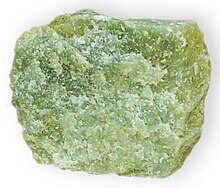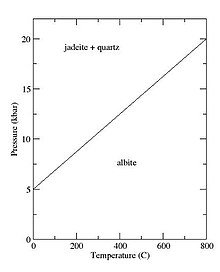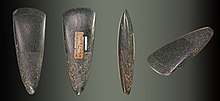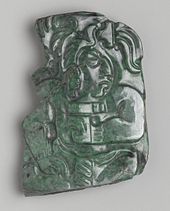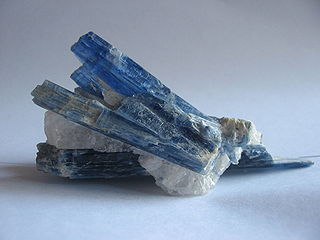
Kyanite is a typically blue aluminosilicate mineral, found in aluminium-rich metamorphic pegmatites and sedimentary rock. It is the high pressure polymorph of andalusite and sillimanite, and the presence of kyanite in metamorphic rocks generally indicates metamorphism deep in the Earth's crust. Kyanite is also known as disthene or cyanite.

In geology and mineralogy, a mineral or mineral species is, broadly speaking, a solid substance with a fairly well-defined chemical composition and a specific crystal structure that occurs naturally in pure form.

Plagioclase is a series of tectosilicate (framework silicate) minerals within the feldspar group. Rather than referring to a particular mineral with a specific chemical composition, plagioclase is a continuous solid solution series, more properly known as the plagioclase feldspar series. This was first shown by the German mineralogist Johann Friedrich Christian Hessel (1796–1872) in 1826. The series ranges from albite to anorthite endmembers (with respective compositions NaAlSi3O8 to CaAl2Si2O8), where sodium and calcium atoms can substitute for each other in the mineral's crystal lattice structure. Plagioclase in hand samples is often identified by its polysynthetic crystal twinning or "record-groove" effect.

The pyroxenes are a group of important rock-forming inosilicate minerals found in many igneous and metamorphic rocks. Pyroxenes have the general formula XY(Si,Al)2O6, where X represents calcium (Ca), sodium (Na), iron or magnesium (Mg) and more rarely zinc, manganese or lithium, and Y represents ions of smaller size, such as chromium (Cr), aluminium (Al), magnesium (Mg), cobalt (Co), manganese (Mn), scandium (Sc), titanium (Ti), vanadium (V) or even iron. Although aluminium substitutes extensively for silicon in silicates such as feldspars and amphiboles, the substitution occurs only to a limited extent in most pyroxenes. They share a common structure consisting of single chains of silica tetrahedra. Pyroxenes that crystallize in the monoclinic system are known as clinopyroxenes and those that crystallize in the orthorhombic system are known as orthopyroxenes.

Actinolite is an amphibole silicate mineral with the chemical formula Ca2(Mg4.5–2.5Fe2+0.5–2.5)Si8O22(OH)2.

Jade is an umbrella term for two different types of ornamental rocks used as jewelry, in jewelry or for ornaments. Jade is often referred to by either of two different silicate mineral names: nephrite, or jadeite. Nephrite is typically green, although may be yellow, white or black. Jadeite varies from white or near-colorless, through various shades of green, to lavender, yellow, orange, brown and black. Rarely it may be blue. However these names are mineralogically incorrect. Both the amphibole jade (nephrite) and pyroxene jade are actually mineral aggregates (rocks) rather than mineral species and thus should not be described by mineral species names. Nephrite was depreciated by the International Mineralogical Association as a mineral species name in 1978. This makes the name "nephrite" mineralogically correct for referring to the rock. As for jadeite, since this is a legitimate mineral species, its name should not be used for the pyroxene jade rock. In China, the name jadeite has been replaced with fei cui, the traditional Chinese name for this gem that was in use long before Damour created the name in 1863.

Pyrophyllite is a phyllosilicate mineral composed of aluminium silicate hydroxide: Al2Si4O10(OH)2. It occurs in two forms (habits): crystalline folia and compact masses; distinct crystals are not known.

Blueschist, also called glaucophane schist, is a metavolcanic rock that forms by the metamorphism of basalt and rocks with similar composition at high pressures and low temperatures, approximately corresponding to a depth of 15–30 km (9.3–18.6 mi). The blue color of the rock comes from the presence of the predominant minerals glaucophane and lawsonite.

Clinozoisite is a complex calcium aluminium sorosilicate mineral with formula: Ca2Al3(Si2O7)(SiO4)O(OH). It forms a continuous solid solution series with epidote by substitution of iron(III) in the aluminium (m3 site) and is also called aluminium epidote.

The use of jade in Mesoamerica for symbolic and ideological ritual was highly influenced by its rarity and value among pre-Columbian Mesoamerican cultures, such as the Olmec, the Maya, and the various groups in the Valley of Mexico. Although jade artifacts have been created and prized by many Mesoamerican peoples, the Motagua River valley in Guatemala was previously thought to be the sole source of jadeite in the region.

Omphacite is a member of the clinopyroxene group of silicate minerals with formula: (Ca, Na)(Mg, Fe2+, Al)Si2O6. It is a variably deep to pale green or nearly colorless variety of clinopyroxene. It normally appears in eclogite, which is the high-pressure metamorphic rock of basalt. Omphacite is the solid solution of Fe-bearing diopside and jadeite. It crystallizes in the monoclinic system with prismatic, typically twinned forms, though usually anhedral. Its space group can be P2/n or C2/c depending on the thermal history. It exhibits the typical near 90° pyroxene cleavage. It is brittle with specific gravity of 3.29 to 3.39 and a Mohs hardness of 5 to 6.

Lawsonite is a hydrous calcium aluminium sorosilicate mineral with formula CaAl2Si2O7(OH)2·H2O. Lawsonite crystallizes in the orthorhombic system in prismatic, often tabular crystals. Crystal twinning is common. It forms transparent to translucent colorless, white, pink, and bluish to pinkish grey glassy to greasy crystals. Refractive indices are nα = 1.665, nβ = 1.672 – 1.676, and nγ = 1.684 – 1.686. It is typically almost colorless in thin section, but some lawsonite is pleochroic from colorless to pale yellow to pale blue, depending on orientation. The mineral has a Mohs hardness of 7.5 and a specific gravity of 3.09. It has perfect cleavage in two directions and a brittle fracture.

Jadeite is presumed one of the most precious materials of Pre-Columbian Costa Rica. It, along with other similar-looking greenstones were cherished and worked for years. Jadeite was used to decorate the body and was presumably a symbol of power.

Jadeitite is a metamorphic rock found in blueschist-grade metamorphic terranes. It is found in isolated metasomatically altered rock units within serpentinite associated with subduction zone environments. Jadeitite consists almost entirely of the pyroxene mineral jadeite and is typically mined as a source of the ornamental rock or gemstone, jade. Occurrences include Myanmar, Guatemala, Japan, Kazakhstan and in the Coast Ranges of western North America.
Sierra de las Minas is a mountain range in eastern Guatemala, extending 130 km west of the Lake Izabal. It is 15–30 km wide and bordered by the valleys of the rivers Polochic in the north and the Motagua in the south. Its western border is marked by the Salamá River valley which separates it from the Chuacús mountain range. The highest peak is Cerro Raxón at 3,015 m. The Sierra's rich deposits of jade and marble have been mined throughout the past centuries. These small scale mining activities also explain the name of the mountain range.

Greenstone is a common generic term for valuable, green-hued minerals and metamorphosed igneous rocks and stones which early cultures used in the fashioning of hardstone carvings such as jewelry, statuettes, ritual tools, and various other artifacts. Greenstone artifacts may be made of greenschist, chlorastrolite, serpentine, omphacite, chrysoprase, olivine, nephrite, chloromelanite among other green-hued minerals. The term also includes jade and jadeite, although these are perhaps more frequently identified by these latter terms. The greenish hue of these rocks generally derives from the presence of minerals such as chlorite, hornblende, or epidote.
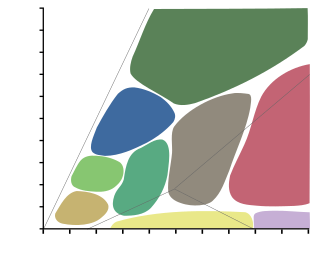
A metamorphic facies is a set of mineral assemblages in metamorphic rocks formed under similar pressures and temperatures. The assemblage is typical of what is formed in conditions corresponding to an area on the two dimensional graph of temperature vs. pressure. Rocks which contain certain minerals can therefore be linked to certain tectonic settings, times and places in the geological history of the area. The boundaries between facies are wide because they are gradational and approximate. The area on the graph corresponding to rock formation at the lowest values of temperature and pressure is the range of formation of sedimentary rocks, as opposed to metamorphic rocks, in a process called diagenesis.

Clinopyroxene thermobarometry is a scientific method that uses the mineral clinopyroxene to determine the temperature and pressure of the magma when the mineral crystalized. Clinopyroxene is found in many igneous rocks, so the method can be used to determine information about the entire rock. Many different minerals can be used for geothermobarometry, but clinopyroxene is especially useful because it's a common phenocryst in igneous rocks and easy to identify, and the crystallization of jadeite, a type of clinopyroxene, implies a growth in molar volume, making it a good indicator of pressure.

A subduction zone is a region of the Earth's crust where one tectonic plate moves under another tectonic plate; oceanic crust gets recycled back into the mantle and continental crust gets created by the formation of arc magmas. Arc magmas account for more than 20% of terrestrially produced magmas and are produced by the dehydration of minerals within the subducting slab as it descends into the mantle and are accreted onto the base of the overriding continental plate. Subduction zones host a unique variety of rock types created by the high-pressure, low-temperature conditions a subducting slab encounters during its descent. The metamorphic conditions the slab passes through in this process creates and destroys water bearing (hydrous) mineral phases, releasing water into the mantle. This water lowers the melting point of mantle rock, initiating melting. Understanding the timing and conditions in which these dehydration reactions occur, is key to interpreting mantle melting, volcanic arc magmatism, and the formation of continental crust.

Antigorite is a lamellated, monoclinic mineral in the phyllosilicate serpentine subgroup with the ideal chemical formula of (Mg,Fe2+)3Si2O5(OH)4. It is the high-pressure polymorph of serpentine and is commonly found in metamorphosed serpentinites. Antigorite, and its serpentine polymorphs, play an important role in subduction zone dynamics due to their relative weakness and high weight percent of water (up to 13 weight % H2O). It is named after its type locality, the Geisspfad serpentinite, Valle Antigorio in the border region of Italy/Switzerland and is commonly used as a gemstone in jewelry and carvings.
